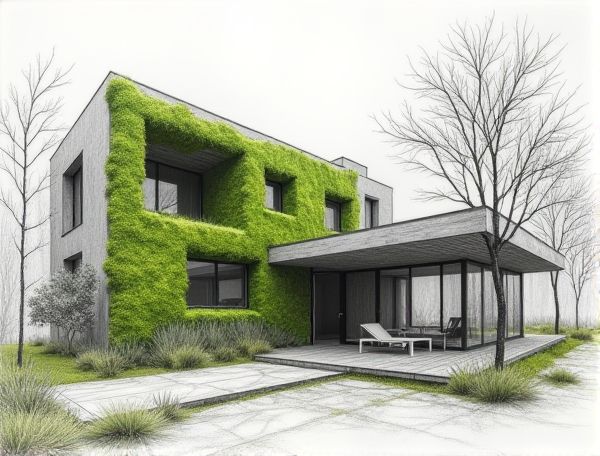
Photo illustration: Biophilic home design with living moss walls
Incorporating living moss walls into your home design enhances indoor air quality and creates a calming natural atmosphere that promotes well-being. Explore the full article to discover how biophilic design can transform your living space into a serene oasis.
Introduction to Biophilic Home Design
Biophilic home design integrates natural elements like sunlight, plants, and organic materials to enhance well-being and reduce stress. Incorporating features such as indoor gardens, natural ventilation, and water elements creates a harmonious living space that connects occupants with nature.
The Science Behind Moss Walls
Moss walls utilize natural biofiltration properties to improve indoor air quality by absorbing airborne pollutants and releasing oxygen. Their unique cellular structure retains moisture, regulating indoor humidity and reducing noise levels through sound absorption. Scientifically proven to enhance wellbeing, moss walls combine aesthetic appeal with sustainable environmental benefits in modern home design.
Benefits of Living Moss Walls in Homes
Living moss walls improve indoor air quality by naturally filtering toxins and increasing oxygen levels, promoting a healthier environment. They act as natural sound insulators, reducing noise pollution and enhancing your home's tranquility. Incorporating moss walls adds a unique aesthetic appeal while requiring minimal maintenance compared to traditional plants, making it an eco-friendly design choice for your living space.
Types of Moss Suitable for Interior Walls
Sheet moss, reindeer moss, and cushion moss are popular types of moss ideal for interior walls due to their low maintenance and ability to retain a vibrant green appearance without soil. These moss varieties thrive in indirect light and moderate humidity, making them perfect for living walls, framed art, and vertical garden installations in indoor home designs.
Design Ideas for Biophilic Moss Wall Features
Integrating biophilic moss wall features enhances your home's ambiance by introducing natural textures and improving indoor air quality. These living walls require minimal maintenance while offering sound absorption and a unique focal point in any room. Choosing preserved moss ensures longevity and vibrant greenery without the need for sunlight or watering, making it ideal for modern interior designs.
Installation Process: Moss Walls at Home
Moss wall installation begins with selecting a suitable moisture-resistant backing board, followed by securely mounting it on a clean, dry wall surface to ensure stability and longevity. The moss panels are then carefully attached using non-toxic adhesives or framing systems, with attention to maintaining proper humidity and indirect light conditions for optimal preservation and minimal maintenance.
Maintenance and Care for Living Moss Walls
Living moss walls require regular misting to maintain optimal humidity levels and prevent drying, ensuring vibrant, healthy foliage. Routine dusting and avoiding direct sunlight extend the moss's lifespan while preserving its natural texture and color.
Environmental Impact of Moss Wall Integration
Integrating moss walls in home design significantly reduces indoor air pollutants by naturally filtering volatile organic compounds (VOCs) and carbon dioxide, contributing to improved air quality. These living installations also support energy efficiency through natural insulation, decreasing heating and cooling demands, which lowers overall carbon emissions. Utilizing moss walls encourages sustainable building practices by incorporating renewable, low-maintenance greenery that minimizes the ecological footprint compared to traditional decorative materials.
Cost Considerations and Budgeting Tips
Accurate cost estimation in home designing involves detailed analysis of materials, labor, permits, and unexpected expenses, typically accounting for 10-20% contingency in the budget. Prioritizing essential features and selecting cost-effective alternatives like engineered wood or recycled materials can significantly reduce overall costs. Utilizing budgeting tools and consulting with experienced architects or contractors ensures alignment of design goals with financial constraints.
Inspiring Examples of Moss Walls in Biophilic Homes
Moss walls in biophilic homes create lush, natural focal points that enhance indoor air quality and promote well-being through their vibrant green textures. These living walls require minimal maintenance, thrive in low-light conditions, and seamlessly integrate with wood, stone, and natural light to elevate eco-friendly interior design.
 homedesy.com
homedesy.com